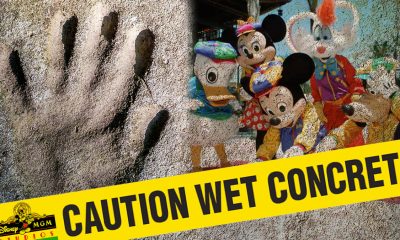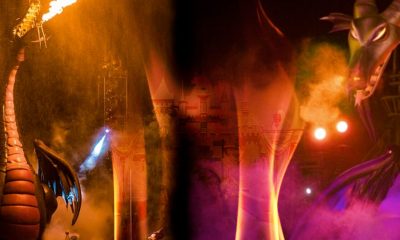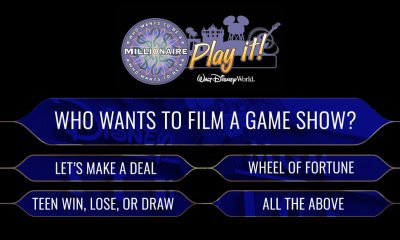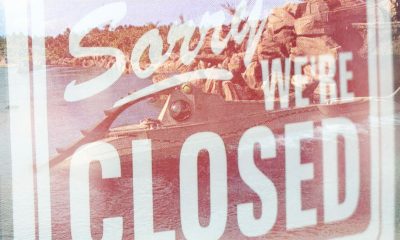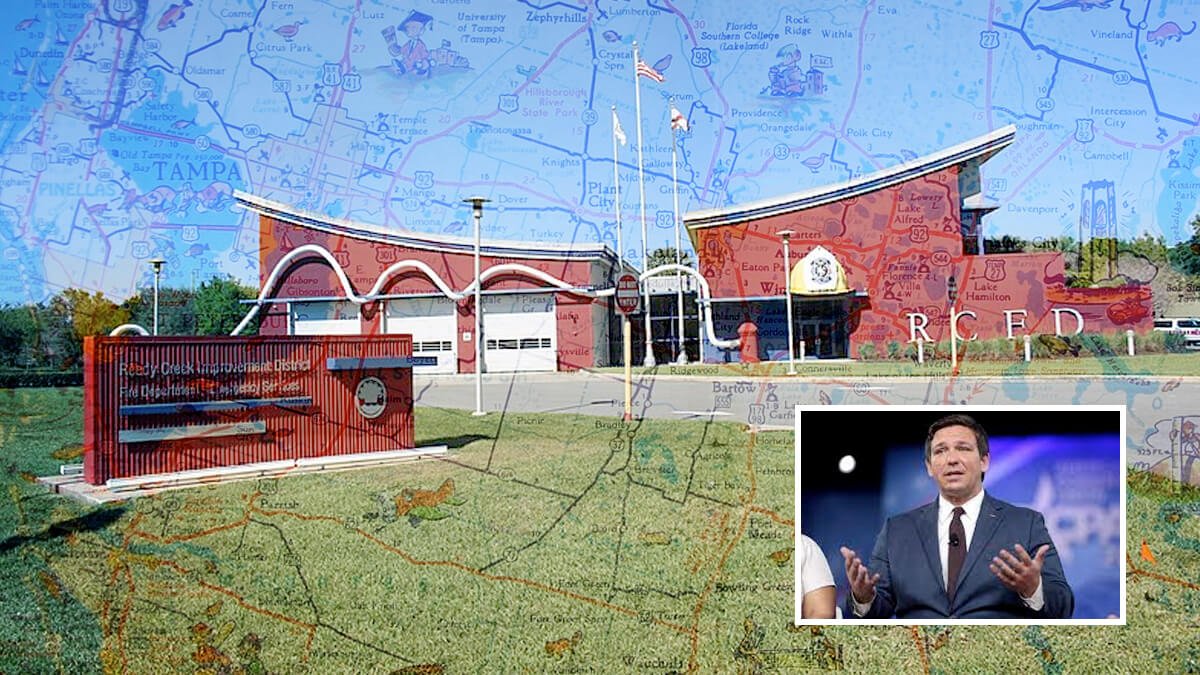
This article is part of a series – History of Reedy Creek Improvement District. Be sure to check out our additional research on the RCID.
Back in the 1960s, Florida legislators weren’t picking fights with Disney Corporate. But rather, they welcomed the Mouse with open arms.
Do you remember how — on November 15, 1965 — Florida Governor Haydon Burns actually shared a dais with Walt Disney & his brother Roy at the Cherry Plaza Hotel in Orlando as they then shared their plans for Project Florida ?
Florida Representatives Meet in Burbank
Well, what doesn’t get talked about all that often is what happened just one month later . On December 16, 1965 , a delegate of some of the most powerful people in Florida flew from Tallahassee to Burbank. We’re talking:
- Fred “Bud” Dickinson , the State Comptroller
- J. Ed Straughn, the director of the Florida Revenue Commission
- Wilken McDuff & Edward Cowart, both prominent attorneys within the Attorney General’s Office
- And Joseph Chapman, administrative assistant to Governor Haydon Burns
These gentlemen — along with key members of their support staff — made a special trip out to California just days before Christmas because, in the eyes of Governor Haydon Burns, this matter just could not wait. The Disney World Project was seen as such a huge opportunity for Florida that the state’s elected officials had to move with all due speed.
So a month and a day after Walt first spoke — in pretty non-specific terms, mind you — about what his Company was thinking about doing with that 43 square miles of swampland in Central Florida it had just purchased, here was a delegation from Tallahassee meeting personally with Walt & Roy so that they could then better understand the whole of Walt Disney Productions. More importantly, so that these elected officials could then make it easier for the Mouse to quickly set up shop in the Sunshine State.
As Walt’s brother recounted in an article that was published about these state officials’ trip to Disney Corporate Headquarters in the December 1965 – January 1966 issue of “The Disney World,” the Company’s in-house newsletter back then:
“They need to study our operation in considerable detail so that they can then advise us on how Florida tax laws would apply to our proposed project,” Roy said.
Touring WED and Disneyland
After they spent the morning with Walt & Roy drilling down into the specifics of Project Florida, the team from Tallahassee was then taken over to Glendale. Where they then toured WED (which is where all of the rides, shows & attractions for the Disney Parks were designed). More importantly, this was where the folks from Florida got their very first glimpse at what the Imagineers were actually dreaming up for Disney World.
To make sure that — when the team from Tallahassee flew back home to Florida — they had only good things to say about everything they’d seen … After WED closed for the day, the folks from Florida were then invited to linger at this facility after-hours. You see, that night ( Friday, December 17 th ) was when Imagineering held its third annual holiday party / open house. So there was plenty of food & drink on hand. Not to mention the opportunity to schmooze with Disney stars like Dick Van Dyke & Dean Jones .
The very next day, this delegation from Florida was then driven down to Anaheim. Where they were then given a thorough behind-the-scenes tour of Disneyland Park. With the idea that they’d then have an intimate understanding of how an East Coast version of this family fun park might operate. After this backstage tour was over, the team from Tallahassee was then cut loose to explore Disneyland on their own / experience many of the Park’s rides, shows & attractions for a few hours.
That evening, the Florida delegation regrouped in Town Square. Where they were then Walt’s personal guests at the premiere of that year’s edition of Disneyland’s holiday parade.
These elected officials then flew home on Sunday. And — on Monday morning — walked back into the state capital and then told the Governor “Give Disney whatever it wants. We have to bring this project to Florida. We will make so much damn money.”
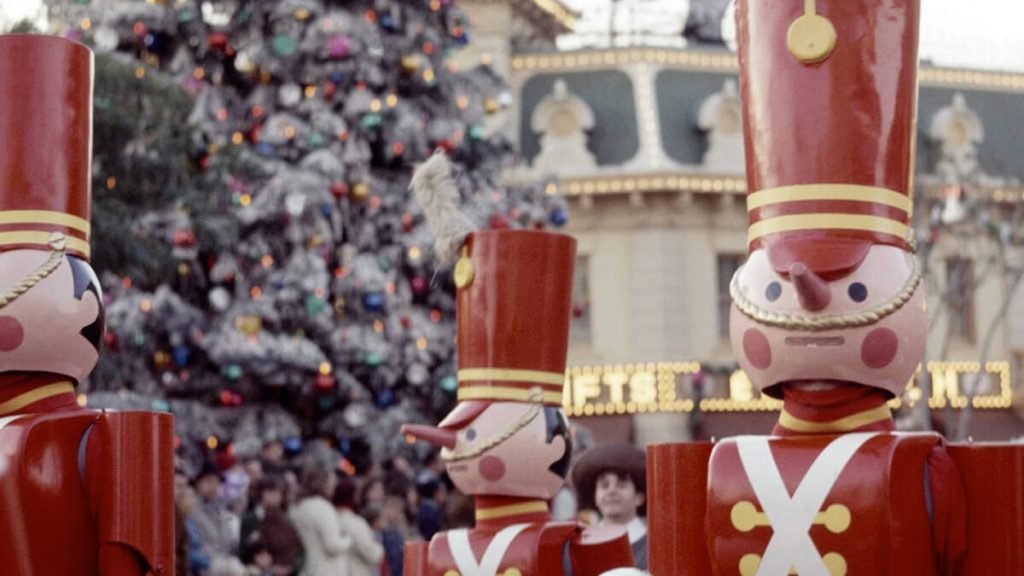
Excitement About EPCOT: Event at Park West Theater
We jump ahead to February of 1967 . Which is when Walt Disney Productions — in an invitation-only event that’s held in the Park West Theater in Winter Park, FL — shows people other than that selected delegation that flew out to Burbank in December of 1965 — exactly what the Company’s plans are for all that swampland in Orange & Osceola County.
908 leaders from the local community cram into this auditorium and are just dazzled by what the Disney team presents. Which — at that time, anyway — call for developing (over time) 20,000 of the 27,500 acres that the Mouse now owned in Central Florida.
It’s important to stress here that a lot of what excited the audience in the Park West Theater wasn’t that Vacation Kingdom the Imagineers wanted to build next to Bay Lake (i.e., The Magic Kingdom and the monorail resorts right outside that theme park). But — rather — Phase 2 of Project Florida. Which was supposed to see a city of the future (with a 30 story-tall skyscraper at its very center) and its adjacent industrial park. Which was then — in Walt’s own words — supposed to eventually become “ … “ … a showplace for American free enterprise.”
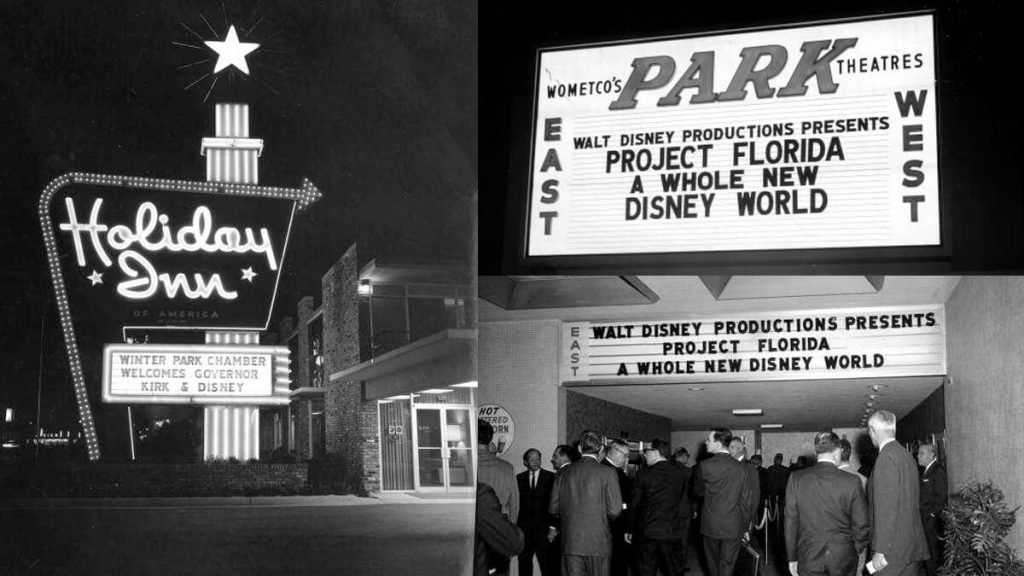
It was this part of Project Florida that especially tantalized the folks up in Tallahassee. Think about it: If Disney had actually built Epcot-the-City and that radial design industrial park right next door, Central Florida wouldn’t just become a tourism destination thanks to the Magic Kingdom and the monorail resorts. But rather, Walt Disney World could have potentially turned this part of the State into a second Cape Canaveral. A place where thousands of highly paid folks would then have worked at full-time hi-tech jobs.
Those folks who worked in Epcot’s industrial park would have had to live locally. And the money that they made from those high paying, hi-tech jobs in this showcase for American industry would have then poured right back into the local economy.
It was this aspect of Project Florida — rather than the Vacation Kingdom — that really powered the push to ram the Reedy Creek Improvement District legislation through. If you thought that Ron DeSantis ’ response to Disney’s opposition to Florida’s “Parental Rights in Education “ legislation (AKA the “Don’t Say Gay” bill) was fast, consider this: That presentation in the Park West Theater was held in February 2, 1967 .
Fast-tracking the Reedy Creek Improvement District
By May 12 th of that same year (Just three months and 10 days later), the bill that gave Walt Disney Productions the right to … Well, not only to build 18 story-tall castles and install cutting-edge transportation systems without seeking the approval from some local planning commission — not to mention collecting taxes and issuing bonds — was being signed into law. In a ceremony that’s held in the garden at the Governor’s mansion, no less.
I also want to stress here that — back then, anyway — the Reedy Creek Improvement District had bipartisan support. Haydon Burns — the governor who shared the dais with Walt & Roy at the Cherry Plaza Hotel in November of 1965 — was a Democrat. Whereas Claude Kirk — the governor who actually signed this bill into law in May of 1967 — was a Republican. The first Republican governor the State of Florida had had since the Reconstruction, I might add.

A bit more background here: At this special signing ceremony in the garden of the Governor’s mansion in Florida, Roy O. Disney went out of his way to state publicly that …
The entire delegation from Orange and Osceola County, in which we will soon be making our home, have given us the upmost in cooperation since the inception of this project. I would particularly like to call attention to Senator Bob Elrod and Bill Gunter, and Representatives John Ducker and Henry Land of this delegation. These four men acted as floor leaders and primary sponsors for the Disney legislation.
Roy O. Disney
So — just to be clear here — the Reedy Creek Improvement District wasn’t some sort of shady backroom deal with Walt Disney Productions that suddenly got rammed through by the folks up in Tallahassee in the dark of night. There were all sorts of public hearings and lots of thoughtful discussion about what should actually go into this bill prior to Governor Claude Kirk actually signing the thing.
Dissolving the Reedy Creek Improvement District in 2023: Where is the City of the Future?
That’s why DeSantis’ people are running into so much trouble now. They tried to undo a comprehensive piece of legislation that had been carefully crafted over a period of months by top notch state attorneys (Not to mention Disney’s own corporate lawyers) with a bill that was hastily slapped together over days . Which is why their effort to dissolve the Reedy Creek Improvement District is doomed to fail once it finally gets challenged in court.
Which isn’t to say that Governor DeSantis doesn’t have another card up his sleeve. I’m told that his new plan when it comes to taking on The Walt Disney Company has to do with promises the Mouse made to the State of Florida that then weren’t kept. To be specific, the construction of the City of EPCOT and its adjacent industrial park.
As I mentioned earlier, it was that aspect of Project Florida — rather than the Vacation Kingdom — that really excited Florida legislators back in the mid-1960s . The idea that the State could soon have a second Cape Canaveral of sorts, a second place in Florida where highly educated folks would work at high-tech jobs that paid well (with a good chunk of their salaries being funneled back into the local community via payroll taxes and purchases at area businesses & restaurants) was what ultimately powered Sunshine State officials to grant the Mouse this unprecedented amount of autonomy.
This is how DeSantis’ people are reportedly looking to spin Phase 2 of their dissolve-Reedy-Creek effort. They’re going to say “ … We’re doing this because Disney never actually delivered on their promise to build a city-of-the-future in the swamps of Central Florida. Back in the 1960s , we were promised all of these high paying, high tech jobs. What we got instead were thousands of low paying positions in Disney’s theme parks.”
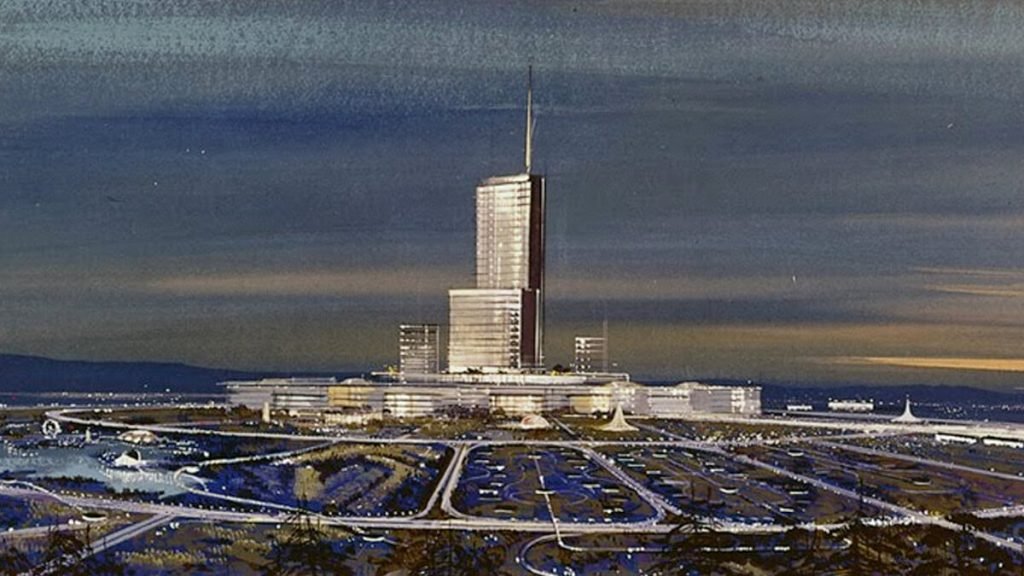
Given that the Walt Disney World Resort is still in the process of celebrating its 50 th , it’ll be hard for the Company to put together a solid response to this line of attack at this particular moment in time . I mean, it’s been five decades now . Shouldn’t that City of the Future — and all of those high paying jobs that were supposed to come along with it — have risen up out of Central Florida’s swamps by now?
Of course, Disney’s response will no doubt involve pointing at Epcot-the-theme park as well as at Celebration. But let’s face it: A theme park and a residential community isn’t exactly a City of the Future or its adjacent industrial park.
Disney’s reportedly readying its response to the anticipated continuation of Governor DeSantis’ effort to dissolve the Reedy Creek Improvement District. That’s one of the main reasons that Geoff Morrell was let go as Disney’s Communications Chief after less than four months on the job. Going forward, the Company wants to take a far more nuanced approach to how Disney Corporate handles the governor of Florida. Who has learned — given how much money has recently poured into DeSantis’ war chest for his potential Presidential run in 2024 — how truly lucrative it can be to attack the Mouse House.
That’s Disney’s real worry right now. That what’s happening in Florida — Disney being pulled into the culture war that’s currently inflamed public discourse across the country — could then become a prairie fire. With other politicians across the United States deciding that they too need to get into the declaring-that-Disney-is-evil game. All with the hope that they too will then be able to fundraise off of this controversy.
The Reedy Creek Improvement District: Yesterday, Today, and Tomorrow
And that — for now, anyway — is the end of our look back at the formation of the Reedy Creek Improvement District. It’s honestly hard to imagine — given how eager Florida officials initially were to make this deal, persuade Disney to spend hundreds of millions of dollars to turn some swampland in Orange & Osceola County into a world class tourist destination — to see the current state of the State’s relationship with the Mouse House. But here we are.
And not to belabor the obvious, but we’ve got another six months ‘til November . Which is when the Mid Terms happen. Not to mention when we learn whether Governor DeSantis winds up getting re-elected as the Governor of Florida. That’s a lot of time for The Walt Disney Company to find itself back in the spotlight in a not-so-flattering fashion.
It’s gonna be interesting to see what happens next.
This article is based on research for The Disney Dish Podcast “Episode 372”, published on April 25, 2022. The Disney Dish Podcast is part of the Jim Hill Media Podcast Network .

History
The Evolution and History of Mickey’s ToonTown

Disneyland in Anaheim, California, holds a special place in the hearts of Disney fans worldwide, I mean heck, it’s where the magic began after all. Over the years it’s become a place that people visit in search of memorable experiences. One fan favorite area of the park is Mickey’s Toontown, a unique land that lets guests step right into the colorful, “Toony” world of Disney animation. With the recent reimagining of the land and the introduction of Micky and Minnies Runaway Railway, have you ever wondered how this land came to be?
There is a fascinating backstory of how Mickey’s Toontown came into existence. It’s a tale of strategic vision, the influence of Disney executives, and a commitment to meeting the needs of Disney’s valued guests.
The Beginning: Mickey’s Birthdayland
The story of Mickey’s Toontown starts with Mickey’s Birthdayland at Walt Disney World’s Magic Kingdom. Opened in 1988 to celebrate Mickey Mouse’s 60th birthday, this temporary attraction was met with such overwhelming popularity that it inspired Disney executives to think bigger. The idea was to create a permanent, immersive land where guests could step into the animated world of Mickey Mouse and his friends.
In the early ’90s, Disneyland was in need of a refresh. Michael Eisner, the visionary leader of The Walt Disney Company at the time, had an audacious idea: create a brand-new land in Disneyland that would celebrate Disney characters in a whole new way. This was the birth of Mickey’s Toontown.
Initially, Disney’s creative minds toyed with various concepts, including the idea of crafting a 100-Acre Woods or a land inspired by the Muppets. However, the turning point came when they considered the success of “Who Framed Roger Rabbit.” This film’s popularity and the desire to capitalize on contemporary trends set the stage for Toontown’s creation.
From Concept to Reality: The Birth of Toontown
In 1993, Mickey’s Toontown opened its gates at Disneyland, marking the first time in Disney Park history where guests could experience a fully realized, three-dimensional world of animation. This new land was not just a collection of attractions but a living, breathing community where Disney characters “lived,” worked, and played.
Building Challenges: Innovative Solutions
The design of Mickey’s Toontown broke new ground in theme park aesthetics. Imagineers were tasked with bringing the two-dimensional world of cartoons into a three-dimensional space. This led to the creation of over 2000 custom-built props and structures that embodied the ‘squash and stretch’ principle of animation, giving Toontown its distinctiveness.
And then there was also the challenge of hiding the Team Disney Anaheim building, which bore a striking resemblance to a giant hotdog. The Imagineers had to think creatively, using balloon tests and imaginative landscaping to seamlessly integrate Toontown into the larger park.

Key Attractions: Bringing Animation to Life
Mickey’s Toontown featured several groundbreaking attractions. “Roger Rabbit’s Car Toon Spin,” inspired by the movie “Who Framed Roger Rabbit,” became a staple of Toontown, offering an innovative ride experience. Gadget’s Go-Coaster, though initially conceived as a Rescue Rangers-themed ride, became a hit with younger visitors, proving that innovative design could create memorable experiences for all ages.
Another crown jewel of Toontown is Mickey’s House, a walkthrough attraction that allowed guests to explore the home of Mickey Mouse himself. This attraction was more than just a house; it was a carefully crafted piece of Disney lore. The house was designed in the American Craftsman style, reflecting the era when Mickey would have theoretically purchased his first home in Hollywood. The attention to detail was meticulous, with over 2000 hand-crafted, custom-built props, ensuring that every corner of the house was brimming with character and charm. Interestingly, the design of Mickey’s House was inspired by a real home in Wichita Falls, making it a unique blend of real-world inspiration and Disney magic.
Mickey’s House also showcased Disney’s commitment to creating interactive and engaging experiences. Guests could make themselves at home, sitting in Mickey’s chair, listening to the radio, and exploring the many mementos and references to Mickey’s animated adventures throughout the years. This approach to attraction design – where storytelling and interactivity merged seamlessly – was a defining characteristic of ToonTown’s success.

Executive Decisions: Shaping ToonTown’s Unique Attractions
The development of Mickey’s Toontown wasn’t just about creative imagination; it was significantly influenced by strategic decisions from Disney executives. One notable input came from Jeffrey Katzenberg, who suggested incorporating a Rescue Rangers-themed ride. This idea was a reflection of the broader Disney strategy to integrate popular contemporary characters and themes into the park, ensuring that the attractions remained relevant and engaging for visitors.
In addition to Katzenberg’s influence, Frank Wells, the then-President of The Walt Disney Company, played a key role in the strategic launch of Toontown’s attractions. His decision to delay the opening of “Roger Rabbit’s Car Toon Spin” until a year after Toontown’s debut was a calculated move. It was designed to maintain public interest in the park by offering new experiences over time, thereby giving guests more reasons to return to Disneyland.
These executive decisions highlight the careful planning and foresight that went into making Toontown a dynamic and continuously appealing part of Disneyland. By integrating current trends and strategically planning the rollout of attractions, Disney executives ensured that Toontown would not only capture the hearts of visitors upon its opening but would continue to draw them back for new experiences in the years to follow.
Global Influence: Toontown’s Worldwide Appeal
The concept of Mickey’s Toontown resonated so strongly that it was replicated at Tokyo Disneyland and influenced elements in Disneyland Paris and Hong Kong Disneyland. Each park’s version of Toontown maintained the core essence of the original while adapting to its cultural and logistical environment.
Evolution and Reimagining: Toontown Today
As we approach the present day, Mickey’s Toontown has recently undergone a significant reimagining to welcome “Mickey & Minnie’s Runaway Railway” in 2023. This refurbishment aimed to enhance the land’s interactivity and appeal to a new generation of Disney fans, all while retaining the charm that has made ToonTown a beloved destination for nearly three decades.

Dive Deeper into ToonTown’s Story
Want to know more about Mickey’s Toontown and hear some fascinating behind-the-scenes stories, then check out the latest episode of Disney Unpacked on Patreon @JimHillMedia. In this episode, the main Imagineer who worked on the Toontown project shares lots of interesting stories and details that you can’t find anywhere else. It’s full of great information and fun facts, so be sure to give it a listen!
History
Unpacking the History of the Pixar Place Hotel

Pixar Place Hotel, the newly unveiled 15-story tower at the Disneyland Resort, has been making waves in the Disney community. With its unique Pixar-themed design, it promises to be a favorite among visitors.
However, before we delve into this exciting addition to the Disneyland Resort, let’s take a look at the fascinating history of this remarkable hotel.
The Emergence of the Disneyland Hotel
To truly appreciate the story of the Pixar Place Hotel, we must turn back the clock to the early days of Disneyland. While Walt Disney had the visionary ideas and funding to create the iconic theme park, he faced a challenge when it came to providing accommodations for the park’s visitors. This is where his friend Jack Wrather enters the picture.
Jack Wrather, a fellow pioneer in the television industry, stepped in to assist Walt Disney in realizing his dream. Thanks to the success of the “Lassie” TV show produced by Wrather’s company, he had the financial means to build a hotel right across from Disneyland.
The result was the Disneyland Hotel, which opened its doors in October 1955. Interestingly, the early incarnation of this hotel had more of a motel feel than a hotel, with two-story buildings reminiscent of the roadside motels popular during the 1950s. The initial Disneyland Hotel consisted of modest structures that catered to visitors looking for affordable lodging close to the park. While the rooms were basic, it marked the beginning of something extraordinary.
The Evolution: From Emerald of Anaheim to Paradise Pier
As Disneyland’s popularity continued to soar, so did the demand for expansion and improved accommodations. In 1962, the addition of an 11-story tower transformed the Disneyland Hotel, marking a significant transition from a motel to a full-fledged hotel.
The addition of the 11-story tower elevated the Disneyland Hotel into a more prominent presence on the Anaheim skyline. At the time, it was the tallest structure in all of Orange County. The hotel’s prime location across from Disneyland made it an ideal choice for visitors. With the introduction of the monorail linking the park and the hotel, accessibility became even more convenient. Unique features like the Japanese-themed reflecting pools added to the hotel’s charm, reflecting a cultural influence that extended beyond Disney’s borders.
Japanese Tourism and Its Impact
During the 1960s and 1970s, Disneyland was attracting visitors from all corners of the world, including Japan. A significant number of Japanese tourists flocked to Anaheim to experience Walt Disney’s creation. To cater to this growing market, it wasn’t just the Disneyland Hotel that aimed to capture the attention of Japanese tourists. The Japanese Village in Buena Park, inspired by a similar attraction in Nara, Japan, was another significant spot.
These attractions sought to provide a taste of Japanese culture and hospitality, showcasing elements like tea ceremonies and beautiful ponds with rare carp and black swans. However, the Japanese Village closed its doors in 1975, likely due to the highly competitive nature of the Southern California tourist market.
The Emergence of the Emerald of Anaheim
With the surge in Japanese tourism, an opportunity arose—the construction of the Emerald of Anaheim, later known as the Disneyland Pacific Hotel. In May 1984, this 15-story hotel opened its doors.
What made the Emerald unique was its ownership. It was built not by The Walt Disney Company or the Oriental Land Company (which operated Tokyo Disneyland) but by the Tokyu Group. This group of Japanese businessmen already had a pair of hotels in Hawaii and saw potential in Anaheim’s proximity to Disneyland. Thus, they decided to embark on this new venture, specifically designed to cater to Japanese tourists looking to experience Southern California.
Financial Challenges and a Changing Landscape
The late 1980s brought about two significant financial crises in Japan—the crash of the NIKKEI stock market and the collapse of the Japanese real estate market. These crises had far-reaching effects, causing Japanese tourists to postpone or cancel their trips to the United States. As a result, reservations at the Emerald of Anaheim dwindled.
To adapt to these challenging times, the Tokyu Group merged the Emerald brand with its Pacific hotel chain, attempting to weather the storm. However, the financial turmoil took its toll on the Emerald, and changes were imminent.
The Transition to the Disneyland Pacific Hotel
In 1995, The Walt Disney Company took a significant step by purchasing the hotel formerly known as the Emerald of Anaheim for $35 million. This acquisition marked a change in the hotel’s fortunes. With Disney now in control, the hotel underwent a name change, becoming the Disneyland Pacific Hotel.
Transformation to Paradise Pier
The next phase of transformation occurred when Disney decided to rebrand the hotel as Paradise Pier Hotel. This decision aligned with Disney’s broader vision for the Disneyland Resort.
While the structural changes were limited, the hotel underwent a significant cosmetic makeover. Its exterior was painted to complement the color scheme of Paradise Pier, and wave-shaped crenellations adorned the rooftop, creating an illusion of seaside charm. This transformation was Disney’s attempt to seamlessly integrate the hotel into the Paradise Pier theme of Disney’s California Adventure Park.
Looking Beyond Paradise Pier: The Shift to Pixar Place
In 2018, Disneyland Resort rebranded Paradise Pier as Pixar Pier, a thematic area dedicated to celebrating the beloved characters and stories from Pixar Animation Studios. As a part of this transition, it became evident that the hotel formally known as the Disneyland Pacific Hotel could no longer maintain its Paradise Pier theme.
With Pixar Pier in full swing and two successful Pixar-themed hotels (Toy Story Hotels in Shanghai Disneyland and Tokyo Disneyland), Disney decided to embark on a new venture—a hotel that would celebrate the vast world of Pixar. The result is Pixar Place Hotel, a 15-story tower that embraces the characters and stories from multiple Pixar movies and shorts. This fully Pixar-themed hotel is a first of its kind in the United States.
The Future of Pixar Place and Disneyland Resort
As we look ahead to the future, the Disneyland Resort continues to evolve. The recent news of a proposed $1.9 billion expansion as part of the Disneyland Forward project indicates that the area surrounding Pixar Place is expected to see further changes. Disneyland’s rich history and innovative spirit continue to shape its destiny.
In conclusion, the history of the Pixar Place Hotel is a testament to the ever-changing landscape of Disneyland Resort. From its humble beginnings as the Disneyland Hotel to its transformation into the fully Pixar-themed Pixar Place Hotel, this establishment has undergone several iterations. As Disneyland Resort continues to grow and adapt, we can only imagine what exciting developments lie ahead for this iconic destination.
If you want to hear more stories about the History of the Pixar Place hotel, check our special edition of Disney Unpacked over on YouTube.
Stay tuned for more updates and developments as we continue to explore the fascinating world of Disney, one story at a time.
History
From Birthday Wishes to Toontown Dreams: How Toontown Came to Be

In the latest release of Episode 4 of Disney Unpacked, Len and I return, joined as always by Disney Imagineering legend, Jim Shull . This two-part episode covers all things Mickey’s Birthday Land and how it ultimately led to the inspiration behind Disneyland’s fan-favorite land, “Toontown”. But let’s not get ahead of ourselves here. It all starts in the early days at Disneyland.
Early Challenges in Meeting Mickey
Picture this: it’s the late 1970s and early 1980s, and you’re at Disneyland. You want to meet the one and only Mickey Mouse, but there’s no clear way to make it happen. You rely on Character Guides, those daily printed sheets that point you in Mickey’s general direction. But let’s be honest, it was like finding a needle in a haystack. Sometimes, you got lucky; other times, not so much.

Mickey’s Birthdayland: A Birthday Wish that Came True
Fast forward to the late 1980s. Disney World faced a big challenge. The Disney-MGM Studios Theme Park was under construction, with the company’s marketing machine in full swing, hyping up the opening of Walt Disney World’s third theme park, MGM Studios, in the Spring of 1989. This extensive marketing meant that many people were opting to postpone their family’s next trip to Walt Disney World until the following year. Walt Disney World needed something compelling to motivate guests to visit Florida in 1988, the year before Disney MGM Studios opened.
Enter stage left, Mickey’s Birthdayland. For the first time ever, an entire land was dedicated to a single character – and not just any character, but the mouse who started it all. Meeting Mickey was no longer a game of chance; it was practically guaranteed.

The Birth of Birthdayland: Creative Brilliance Meets Practicality
In this episode, we dissect the birth of Mickey’s Birthdayland, an initiative that went beyond celebrating a birthday. It was a calculated move, driven by guest feedback and a need to address issues dating back to 1971. Imagineers faced the monumental task of designing an experience that honored Mickey while efficiently managing the crowds. This required the perfect blend of creative flair and logistical prowess – a hallmark of Disney’s approach to theme park design.
Evolution: From Birthdayland to Toontown
The success of Mickey’s Birthdayland was a real game-changer, setting the stage for the birth of Toontown – an entire land that elevated character-centric areas to monumental new heights. Toontown wasn’t merely a spot to meet characters; it was an immersive experience that brought Disney animation to life. In the episode, we explore its innovative designs, playful architecture, and how every nook and cranny tells a story.

Impact on Disney Parks and Guests
Mickey’s Birthdayland and Toontown didn’t just reshape the physical landscape of Disney parks; they transformed the very essence of the guest experience. These lands introduced groundbreaking ways for visitors to connect with their beloved characters, making their Disney vacations even more unforgettable.
Beyond Attractions: A Cultural Influence
But the influence of these lands goes beyond mere attractions. Our episode delves into how Mickey’s Birthdayland and Toontown left an indelible mark on Disney’s culture, reflecting the company’s relentless dedication to innovation and guest satisfaction. It’s a journey into how a single idea can grow into a cherished cornerstone of the Disney Park experience.

Unwrapping the Full Story of Mickey’s Birthdayland
Our two-part episode of Disney Unpacked is available for your viewing pleasure on our Patreon page. And for those seeking a quicker Disney fix, we’ve got a condensed version waiting for you on our YouTube channel . Thank you for being a part of our Disney Unpacked community. Stay tuned for more episodes as we continue to “Unpack” the fascinating world of Disney, one story at a time.





